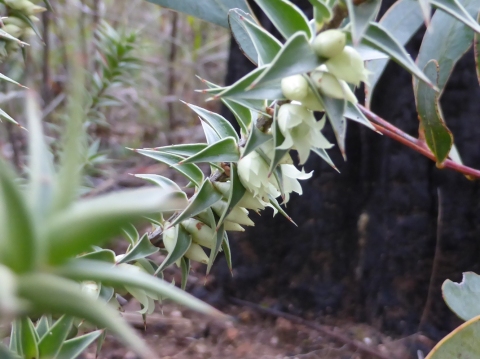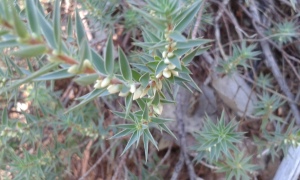Have you heard of urn heath (Melichrus urceolatus)? I hadn’t, until July last year. It grows along most of Australia’s east coast, but only in Box–Gum Grassy Woodland ecosystems (update: also in other ecosystems! see Greg Steenbeeke’s comment below). For most of the year, it’s an unassuming, prickly little shrub, usually less than 1 metre in height. Then in late winter, it bursts into a mass of tiny creamy-white urn-shaped blooms. Each individual flower is only a couple of mm in size. But a shrub in full bloom will stop you in your tracks.

This is what happened last July, as I took my regular afternoon walk through a local urban nature reserve. The reserve (Eastern Hill in Albury, NSW) is a tiny fragment of the Box-Gum Grassy Woodlands that were once common across the region.
This particular urn heath shrub was in full bloom right next to my walking track, but I’d never noticed it before. I didn’t recognise the botanical family, so I stopped to have a closer look, wondering if it was something special. And that’s how I discovered a couple of parasitic wasps supping on nectar inside the tiny urns. They are Diapriidae species, thanks to Ken Walker at Museum Victoria for ID.

How does Ecology benefit from random observations?
Urn heath has no special conservation status, but that doesn’t mean it’s not interesting. The genus Melichrus is endemic to Australia, and includes only 5-7 species. Going by the published scientific literature, there isn’t a great deal known about Melichrus ecology. In particular, no one is quite sure how the flowers are pollinated, although bees are considered the most likely candidates.
Like many plants in fire-prone ecosystems, urn heath is a good post-fire resprouter. A couple of weeks after I spotted the plant in Albury, we went on a road trip holiday through New South Wales. One of the highlights was stopping for a walk in the Warrumbungles National Park, 2.5 years after the fierce bushfires that burned through 80 % of the park. I was excited to find the characteristic little shrub I associated with home blooming from the burnt ground in its northern NSW range!

Urn heath’s floral traits and phenology, along with knowledge of other species in the same Ericaceae sub-family (Styphelioideae), raise some intriguing questions on plant-pollinator relationships.
The flower’s colour (pale green–white) is thought to be almost invisible to bees; but its tubular shape implies animal pollination. The pollen structure (monad units) is mostly found in wind-pollinated plants; but a little appendage at the base of each anther suggests a trigger mechanism for depositing pollen on the backs of insect visitors. The plant blooms in late winter, when most bees and insect pollinators are not active, suggesting it doesn’t rely on insects for pollination; but it also produces copious amounts of nectar, which is a major attractant for animal pollinators.
Another example of why pollination syndromes are rarely realistic!
So what’s the story? Is urn heath insect-pollinated, like most of its relatives? Or does it have a more complicated reproductive strategy? Research is needed to answer these questions. But it’s clearly an interesting plant. In addition to its mysterious pollination ecology, it is obviously an important late winter food source for insects in Box-Gum Grassy Woodlands, at a time when not much else is in flower. Yet the potential for urn heath, and other winter-flowering plants in the Box-Gum woodlands, to support pollinator populations hasn’t been fully investigated.
My natural history note on this observation has just been published in volume 16 of Cunninghamia, one of Australia’s leading (but under-appreciated) natural history journals, focused on plant ecology. It’s open access, so click through to read the full article or download the pdf here.
Postscript: after the article had been accepted, I discovered the same plant in my local reserve had bloomed for a second time, in mid-summer. It burst into new buds just after Christmas, possibly in response to an unseasonal cold snap we had just experienced. Three months later, the buds are still there, unopened, frozen in time, teasing the local pollinators!

Do you know anything about the mysterious urn heath?
© Manu Saunders 2016
I’m a little confused about your comment on the pollen…what do you mean by “monad”? As opposed to tetrad grains like the Ericaceae? Isn’t the majority of angiosperm pollen tricolporate monads? Most of that is carried by insects…
LikeLike
I think the Ericaceae genera have a variety of monads, tetrads, pseudomonads & ambiguous. Melichrus is described as monad units: http://www.journals.uchicago.edu/doi/abs/10.1086/597268 . There are other papers discussing the Stypheloidea, presence of ambophily in some genera & similarities to Cyperaceae…an interesting rabbit hole!
Do you know anything more about this?
LikeLiked by 1 person
Not as much as I would like…from what I’ve learned I just assumed the majority of vectored pollen was monad, so I was confused. It seemed like you were suggesting that its monad nature implied it is wind borne.
LikeLike
I guess to rephrase my question more succinctly: are monads rare in insect borne pollen?
LikeLike
my interpretation from the papers I read was that Melichrus monads were not aggregated…and I thought monads without pollenkitt to keep them together were usually wind-dispersed? but happy for correction, it’s not my area!
LikeLiked by 1 person
I’m not sure! I just realized I might have a misconception…sometimes I make assumptions without thinking and then later find out they were wrong.
LikeLiked by 1 person
Thanks for a good read Manu, but I do have a few problems with the things you wrote about its distribution.
This species is anything but restricted to box gum grassy woodlands. It is found in at least 175 of the 1200+ Plant Community Types in NSW (as interrogated using the presence of the species in the species listed for a community in the VIS-Classification database). A breakdown of the communities using the Veg Classes is as follows:
Floodplain Transition Woodlands; 1
Inland Rocky Hill Woodlands; 13
New England Dry Sclerophyll Forests; 12
New England Grassy Woodlands; 5
Northern Escarpment Wet Sclerophyll Forests; 1
Northern Montane Heaths; 4
Northern Tableland Dry Sclerophyll Forests; 12
Northern Tableland Wet Sclerophyll Forests; 1
North-west Alluvial Sand Woodlands; 1
North-west Slopes Dry Sclerophyll Woodlands; 20
Pilliga Outwash Dry Sclerophyll Forests; 2
Sand Plain Mallee Woodlands; 1
Southern Escarpment Wet Sclerophyll Forests; 1
Southern Tableland Dry Sclerophyll Forests; 4
Southern Tableland Grassy Woodlands; 3
Subalpine Woodlands; 1
Sydney Hinterland Dry Sclerophyll Forests; 2
Tableland Clay Grassy Woodlands; 3
Temperate Montane Grasslands; 1
Upper Riverina Dry Sclerophyll Forests; 12
Western Slopes Dry Sclerophyll Forests; 57
Western Slopes Grasslands; 2
Western Slopes Grassy Woodlands; 5
Yetman Dry Sclerophyll Forests; 11
I have seen it in many of these communities, making me concerned about this statement you made early in the piece. Your assertion about it being in box-gum grassy woodlands is only a small part of the distribution shown by the species – in my experience it really favours any quartz-rich, well-draining soil – which is also somewhat at odds to box-gum grassy woodlands, which tend to favour clay-rich loams. Yes they are in those communities, but I see them much less frequently.
Also, I don’t think it is cold that stimulates flowering in the species but response to a rainfall event large enough to make that response. This is due to me having photographed it in flower in March, May, July, August. The PlantNet site suggests it’s in flower March to November. Your suggestion of Late Winter in my mind relates to your own experience with something which (by your own admission) you had not noticed before. Your post-script is also adding more support to my thinking, with the period about two months before Christmas in Albury (first two weeks in November) having a rainfall event of about 66 mm – a sizeable event in that part of the world.
LikeLiked by 1 person
Wow, thanks so much for the extra info Greg. I could find very little published info on urn heath’s ecology when I was writing up the observation. My interpretation of what was available suggested that it was a grassy woodlands native, and it is listed on all the grassy woodlands plant species lists I looked through. Thanks for the correction – I’ve updated the post above.
Do you have any refs for the rainfall-response flowering? I searched for info on flowering cues, but couldn’t find much in the literature except the consensus that it was winter-flowering.
LikeLike
I don’t know that it’s a field anout which much has been written Alan Stephenson wrote an article for the Orchadian about rainfall triggers in orchids around Nowra and I think it is a field in need of more investigation. Regrettably, where there is good rainfall data density (i.e.more stations per unit area) it tends to be that there are fewer patches of veg in which this phenomenon could be investigated.
It seems though that this would be a prominent trigger in the Australian flora, with such a dynamic rainfall system (tends to be dominated by short term, high volume events) and an overall indistinct climate over much of the landmass (by which I mean the variability apart from daylength is much ĺess than in the better studied northern climes and yet still greater than the better-studied tropical regions).
Would like to see more study on it myself.
LikeLike
We have been eating the fruit of this thorny bush since childhood and who knows how far back Aboriginal people have been eating the fruit before us. I have also noticed the Mookrun which is its Aboriginal name here in Tingha NSW flowering in the middle of winter last year. In February 2019 when we had the Tingha Plateau Bushfire most of the Mookrun plants we knew as kids were burnt out and we didn’t collect any to eat. This year however all the Mookrun plants are loaded with fruit and I actually rang my kids who are in lockdown at Inverell to give them the good news. We should be eating them over the next month I reckon based on what I saw on the weekend.
LikeLiked by 1 person
Very interesting, thanks for sharing!
LikeLike
Thanks Greg! And good to hear from you again – it has been a long time brother!
LikeLike
Thanks Greg! It’s good to hear from you brother – it’s been a long time.
LikeLike